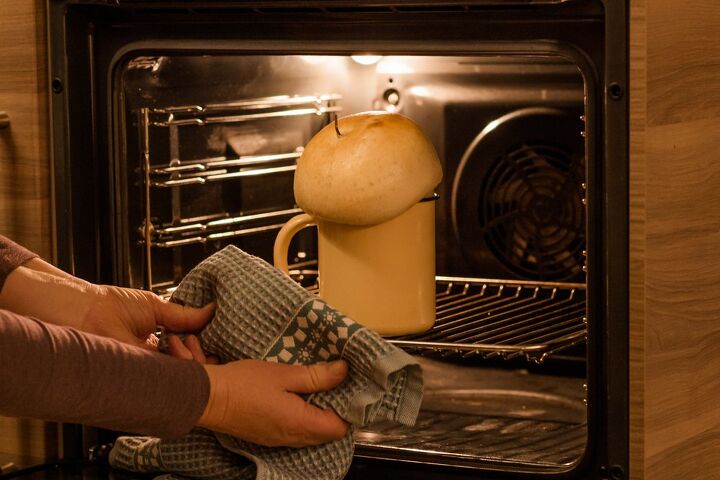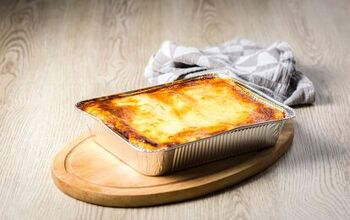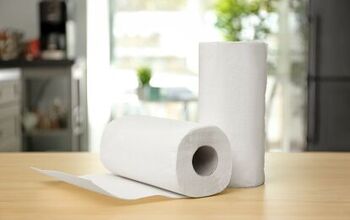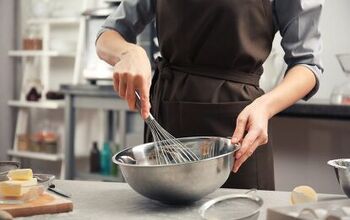Can You Put Coffee Mugs In The Oven? (Find Out Now!)

With one-cup desserts becoming more popular, many people want to know if their coffee mugs are safe in the oven. After all, an oven-baked cake is always better than in the microwave. So, can you cook food in the oven using a coffee cup or not?
You can bake some food using a standard coffee mug, but only if the cup is oven-safe. That means you have to check the label first. Then, remember that you might not be able to bake at high temperatures regardless.
What Happens If You Put a Coffee Mug in the Oven?
You can’t put certain substances into the oven because they could melt. For example, never bake plastic. Plastics can ooze all over your range and then cause a fire. And if a fire starts in your kitchen, it could set off the alarms or trigger the sprinkler system. So, stick with oven-safe materials.
If you put a coffee mug in the oven, a few things could happen. It all depends on the mug’s materials. But here is what you can expect:
- The mug gets hot as the food cooks.
- Your cup cracks or breaks from the heat.
Oven-safe coffee mugs are common. You can find them in most stores. However, not all mugs are the same. Some cups can only handle hot beverages, while others are fit for baking. So, always check the label for more information.
NOTE: Putting hazardous objects in a hot oven is dangerous. And your mug can explode if it gets too steamy.
How Do You Know If a Mug Is Oven Safe?
Usually, aluminum foil is safe in convection ovens. Plus, you can bake on cardboard if you use the right appliances. Meanwhile, tempered glass and ceramic are durable as well. And so are specific types of porcelain.
You can tell whether cookware is oven-safe by checking the label. Most pieces have a sticker on the bottom surface. But you can also find that information on the box. Ceramics, stoneware, and tempered glasses are your best bets, though.
What Temperature Does Ceramic Crack?
It’s not easy to crack ceramic, especially if it’s oven-safe. That’s because high heat doesn’t damage ceramic as much as it does other materials. Thus, your favorite ceramic mug is perfect for making single-serving recipes.
However, you can’t let the oven get too hot. Consumer ceramics can withstand about 440 degrees (F) with no problems. And ceramics won’t start to crack until the temperature reaches well above 1000 degrees (F).
CAUTION: Despite their durability, ceramic mugs will still be hot when you take them out of the oven.
How Do I Bake a Mug in the Oven?
You can bake a coffee mug even if it’s not ceramic. As long as the dish is oven-safe, you should be fine. So, here’s how to make your favorite one-mug recipes safely:
- Try to place your cup inside the furnace before it preheats.
- Turn your oven on and set it to 350°F.
- Bake your mug for up to 30 minutes at that temperature.
Did you know that you can bake coffee cups more than once? So, oven-ready mugs are perfect for crafts and other creative projects. However, always check the label for an “oven-safe” symbol and bake in short increments. That way, you can avoid trouble.
Can Porcelain Go Into the Oven?
Porcelain cookware is usually safe in the oven below specific temperatures. In most cases, you can go as high as 570°F without a problem. Plus, your food cooks more evenly when you put it in porcelain. And it also produces a gooey inside with a crispy outside.
How Do You Tell If Your Oven Is Damaging Dishes?
If baking your coffee mugs becomes a problem, you’ll be able to tell. Just look for cracks in your cup. They’ll begin at the bottom, where most of the heat collects. But you might see signs of trouble around the edges as well.
Carefully remove your mug from the oven if you spot an issue. First, turn off the stove. Then, open the door to let the heat escape. After a few minutes, reach in and retrieve your cup. And don’t forget to let it cool before you remove the food.
Related Questions
Can You Put Ceramics in the Microwave?
Since ceramic doesn’t contain water, you can usually put it in the microwave. And you can do the same with glass and plastic. That’s because the electrons can freely move while your food heats. So, you won’t have to deal with melting or cracking as a result.
What Ceramics Are Oven Safe?
Most ceramics are oven-safe by design. But stoneware, tempered glass, and enamelware are as well. You can bake at temperatures up to 350°F in most cases. However, Pyrex, Corningware, and metal are also safe choices.
Is Ceramic or Porcelain Better?
Whether ceramic or porcelain is better depends on what you’re baking. In general, ceramic is more durable than porcelain. It doesn’t wear as easily. And it doesn’t break as quickly either. However, ceramic may absorb more water than porcelain because it’s porous.
Will Cold Ceramic Crack in the Oven?
You should never place cold dishes directly in the oven. It doesn’t matter if they’re ceramic, porcelain, metal, or otherwise. That’s because sudden temperature changes can destroy the integrity of your cookware. And even if you don’t notice a problem right away, you could the next time you cook.
Bake with Confidence
Create delicious recipes in your oven using a durable coffee mug. But pay attention to the materials. And don’t forget that there’s a difference between conventional and convection ovens. You might be able to bake one-cup goodies, or you might not.
Related Guides

Tiffany Nichols specializes in aesthetics, design, marketing, and manufacturing. She's a copywriter and editor for several home renovation companies in the U.S. and works alongside some of the biggest names in the industry. Her hobbies include architecture, art, mental health, and fashion.
More by Tiffany Nichols

























![Standard Dining Room Table Dimensions [for 4, 6, 8, 10 and 12 People]](https://cdn-fastly.upgradedhome.com/media/2023/07/31/9074335/standard-dining-room-table-dimensions-for-4-6-8-10-and-12-people.jpg?size=350x220)

